
Elsevier is a Netherlands-based publishing company specializing in scientific, technical, and medical content. It is a part of the RELX Group, known until 2015 as Reed Elsevier. Its products include journals such as The Lancet and Cell, the ScienceDirect collection of electronic journals, the Trends and Current Opinion series of journals, the online citation database Scopus, the SciVal tool for measuring research performance, the ClinicalKey search engine for clinicians, and the ClinicalPath evidence-based cancer care service. Elsevier's products and services also include digital tools for data management, instruction, research analytics and assessment.
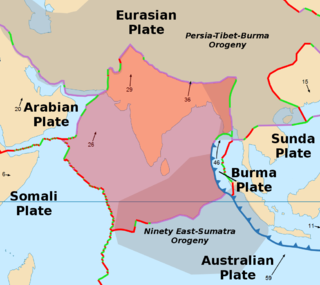
The Indian Plate or India Plate is a minor tectonic plate straddling the Equator in the Eastern Hemisphere. Originally a part of the ancient continent of Gondwana, India broke away from the other fragments of Gondwana 100 million years ago and began moving north. Once fused with the adjacent Australian Plate to form a single Indo-Australian Plate, recent studies suggest that India and Australia have been separate plates for at least 3 million years and likely longer. The Indian Plate includes most of South Asia—i.e. the Indian subcontinent—and a portion of the basin under the Indian Ocean, including parts of South China and western Indonesia, and extending up to but not including Ladakh, Kohistan and Balochistan.

The SSRN, formerly known as Social Science Research Network, is a repository for preprints devoted to the rapid dissemination of scholarly research in the social sciences, humanities, life sciences, health sciences, and more. Elsevier bought SSRN from Social Science Electronic Publishing Inc. in May 2016.

Cell is a peer-reviewed scientific journal publishing research papers across a broad range of disciplines within the life sciences. Areas covered include molecular biology, cell biology, systems biology, stem cells, developmental biology, genetics and genomics, proteomics, cancer research, immunology, neuroscience, structural biology, microbiology, virology, physiology, biophysics, and computational biology. The journal was established in 1974 by Benjamin Lewin and is published twice monthly by Cell Press, an imprint of Elsevier.
The Pan-African orogeny was a series of major Neoproterozoic orogenic events which related to the formation of the supercontinents Gondwana and Pannotia about 600 million years ago. This orogeny is also known as the Pan-Gondwanan or Saldanian Orogeny. The Pan-African orogeny and the Grenville orogeny are the largest known systems of orogenies on Earth. The sum of the continental crust formed in the Pan-African orogeny and the Grenville orogeny makes the Neoproterozoic the period of Earth's history that has produced most continental crust.
Christopher R. Scotese is an American geologist and paleogeographer. He received his PhD from the University of Chicago in 1985. He is the creator of the Paleomap Project, which aims to map Earth over the last billion years, and is credited with predicting Pangaea Ultima, a possible future supercontinent configuration. Later Dr. Scotese changed Pangaea Ultima to Pangaea Proxima to alleviate confusion about the name Pangaea Ultima, which would imply that it would be the last supercontinent.
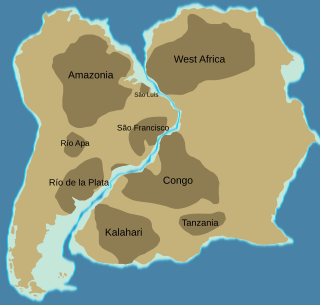
The Amazonian Craton is a geologic province located in South America. It occupies a large portion of the central, north and eastern part of the continent. The Guiana Shield and Central Brazil Shield constitutes respectively the northern and southern exhumed parts of the craton. Between the two shields lies the Amazon Rift, a zone of weakness within the craton. Smaller cratons of Precambrian rocks south of the Amazonian Shield are the Río de la Plata Craton and the São Francisco Craton, which lies to the east.

Austral Ecology: A Journal of Ecology in the Southern Hemisphere is a peer-reviewed scientific journal covering research related to the ecology of land, marine, and freshwater systems in the Southern Hemisphere. It is published by Wiley and is the official journal of the Ecological Society of Australia. The journal addresses the commonality between ecosystems in Australia and many parts of southern Africa, South America, New Zealand, and Oceania. For example, many species in the unique biotas of these regions share common Gondwana ancestors. The journal was established in 1976 as Australian Journal of Ecology, obtaining its current name in 2000. As of 2017, the editor-in-chief is Nigel Andrew.

Gondwana was a supercontinent that formed during the late Neoproterozoic and began to break up during the Jurassic, with the final stages of breakup, including the opening of the Drake Passage separating South America and Antarctica occurring during the Paleogene. Gondwana was not considered a supercontinent by the earliest definition, since the landmasses of Baltica, Laurentia, and Siberia were separated from it. It is also commonly called Gondwanaland, a tautology because Gondwana is originally 'Land of the Gonds'.
Biochimica et Biophysica Acta (BBA) is a peer-reviewed scientific journal in the field of biochemistry and biophysics that was established in 1947. The journal is published by Elsevier with a total of 100 annual issues in ten specialised sections.
The Madagascar Plate or Madagascar block was once attached to the Gondwana supercontinent and later the Indo-Australian Plate.
The Moa Plate was an ancient oceanic plate that formed in the Early Cretaceous south of the Pacific–Phoenix Ridge. The Moa Plate was obliquely subducted beneath the Gondwana margin, and material accreted from it is now part of the Eastern Province of New Zealand. The plate was named in 2001 by Rupert Sutherland and Chris Hollis.
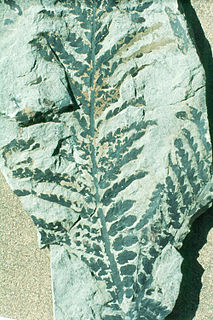
Dicroidium is an extinct genus of fork-leaved seed ferns that were widely distributed over Gondwana during the Triassic. Their fossils are known from South Africa, the Arabian Peninsula, Australia, New Zealand, South America, Madagascar, the Indian subcontinent and Antarctica. They were first discovered in Triassic sediments of Tasmania by Morris in 1845. Fossils from the Umm Irna Formation in Jordan and in Pakistan indicate that these plants already existed in Late Permian. Late surviving members of the genus are known from the Early Jurassic (Sinemurian) of East Antarctica. Within paleobotany, Dicroidium is a form genus used to refers to the leaves, associated with ovuluate organs classified as Umkomasia and pollen organs classified as Pteruchus, while Dicroidum is also used collectively to refer to the whole plant.

Sospeter Mwijarubi Muhongo, FGSAf, FTWAS, FAAS, CGeol, EurGeol, MASSAf, FGIGE, MP is a Tanzanian geologist and a nominated member of the Tanzanian Parliament.
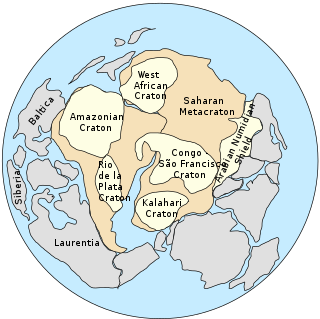
The Saharan Metacraton is a term used by some geologists to describe a large area of continental crust in the north-central part of Africa. Whereas a craton is an old and stable part of the lithosphere, the term "metacraton" is used to describe a craton that has been remobilized during an orogenic event, but where the characteristics of the original craton are still identifiable. The geology of the continent has only been partially explored, and other names have been used to describe the general area that reflect different views of its nature and extent. These include "Nile Craton", "Sahara Congo Craton", "Eastern Saharan Craton" and "Central Saharan Ghost Craton". This last term is because the older rocks are almost completely covered by recent sediments and desert sands, making geological analysis difficult.

The Blue Nile rift is a major geological formation in the Sudan, a rift with a NW trend that terminates on the Central African Shear Zone. It was formed through crustal extension during the break-up of Gondwana.

The Cost of Knowledge is a protest by academics against the business practices of academic journal publisher Elsevier. Among the reasons for the protests were a call for lower prices for journals and to promote increased open access to information. The main work of the project was to ask researchers to sign a statement committing not to support Elsevier journals by publishing, performing peer review, or providing editorial services for these journals.

The Pampean orogeny was an orogeny active in the Cambrian in the western margin of the ancient landmass of Gondwana. The orogen's remains can now be observed in central Argentina, in particular at the Sierras de Córdoba and other parts of the eastern Sierras Pampeanas. It is uncertain if the orogeny involved at some point a continental collision. The Pampean orogen can be considered both part of the larger Terra Australis orogen and of the Brasiliano orogeny. The Pampean orogeny was succeeded by the Famatinian orogeny further west.
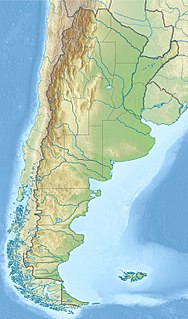
Puncoviscana Formation is a formation of sedimentary and metasedimentary rocks Late Ediacaran and Lower Cambrian age, estimated at between 700 and 535 Ma, that crop out in the Argentine Northwest. Most of the formation lies in Jujuy, Salta and Tucumán Province albeit some authors extend the formation further south to the Sierras Pampeanas near Córdoba.

Brasiliano orogeny or Brasiliano cycle refers to a series of orogenies of Neoproterozoic age exposed chiefly in Brazil but also in other parts of South America. The Brasiliano orogeny is a regional name for the larger Pan-African/Brasiliano orogeny that extended not only in South America but across most of Gondwana. In a wide sense the Brasiliano orogeny includes also the Pampean orogeny. Almeida et al. coined the term Brasiliano Orogenic Cycle in 1973. The orogeny led to the closure of several oceans and aulacogens including the Adamastor Ocean, the Goianides Ocean, the Puncoviscana Ocean and the Peri-Franciscano Ocean.














